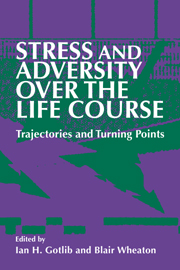Book contents
- Frontmatter
- Contents
- List of contributors
- 1 Trajectories and turning points over the life course: concepts and themes
- I Trajectories: long-term effects of adverse experience
- II Turning points: changes in life trajectories
- 8 Becoming unsupervised: children's transitions from adult-care to self-care in the afterschool hours
- 9 Children whose parents divorce: life trajectories and turning points
- 10 Life after high school: development, stress, and well-being
- 11 Turning points in midlife
- 12 Adaptation to retirement
- III New methods for the study of the life course
- Index
8 - Becoming unsupervised: children's transitions from adult-care to self-care in the afterschool hours
from II - Turning points: changes in life trajectories
Published online by Cambridge University Press: 23 October 2009
- Frontmatter
- Contents
- List of contributors
- 1 Trajectories and turning points over the life course: concepts and themes
- I Trajectories: long-term effects of adverse experience
- II Turning points: changes in life trajectories
- 8 Becoming unsupervised: children's transitions from adult-care to self-care in the afterschool hours
- 9 Children whose parents divorce: life trajectories and turning points
- 10 Life after high school: development, stress, and well-being
- 11 Turning points in midlife
- 12 Adaptation to retirement
- III New methods for the study of the life course
- Index
Summary
In many American families today, no parent returns home from work until hours after the school day has ended. Some children attend formal afterschool programs during these hours or return home to a grandparent or other adult caregiver. During the elementary school years, however, children often begin to spend time after school on their own. Cain and Hofferth (1989) report that 2.4 million children in the United States regularly spend time unsupervised by adults or older teenagers, and that the percentage of children who are unsupervised increases steadily with age.
Children without adult supervision often arouse concern. During World War II, Zucker (1944) saw maladjustment and delinquency looming for “latchkey” children whose mothers sought wartime employment. “The house key tied around the neck is the symbol of cold meals, of a child neglected and shorn of the security of a mother's love and affection” (Zucker 1944, p. 43). As Medrich et al. (1982) observe:
Many feel that children this age should be within safe distance, if not under the actual supervision of adults most of the time. They should move each day from one sphere of adult influence, the school, to another, the home, as rapidly as possible. When this ideal goes unrealized, as it often does, a “problem” is readily inferred, either in parenting or in the social provision of child care.
(p. 63)- Type
- Chapter
- Information
- Stress and Adversity over the Life CourseTrajectories and Turning Points, pp. 159 - 178Publisher: Cambridge University PressPrint publication year: 1997
- 3
- Cited by



